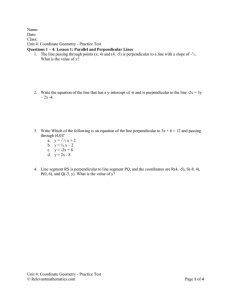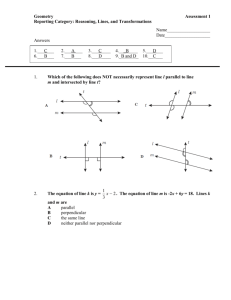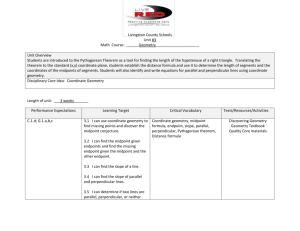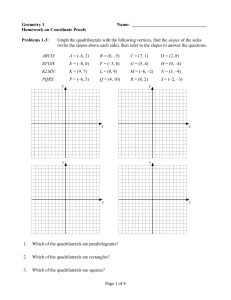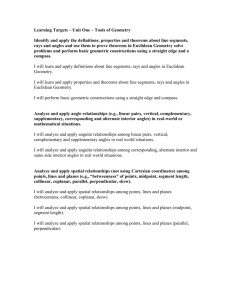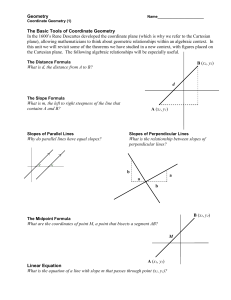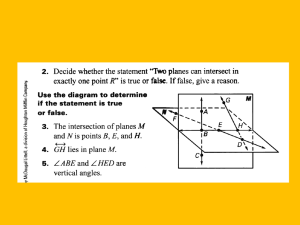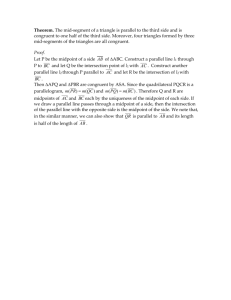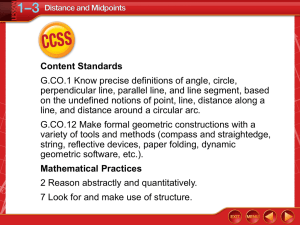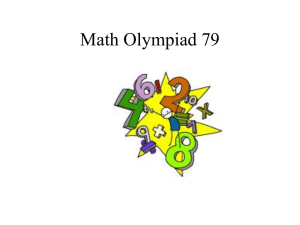Coordinate Geometry Test: Parallel Lines, Distance, Midpoint
advertisement
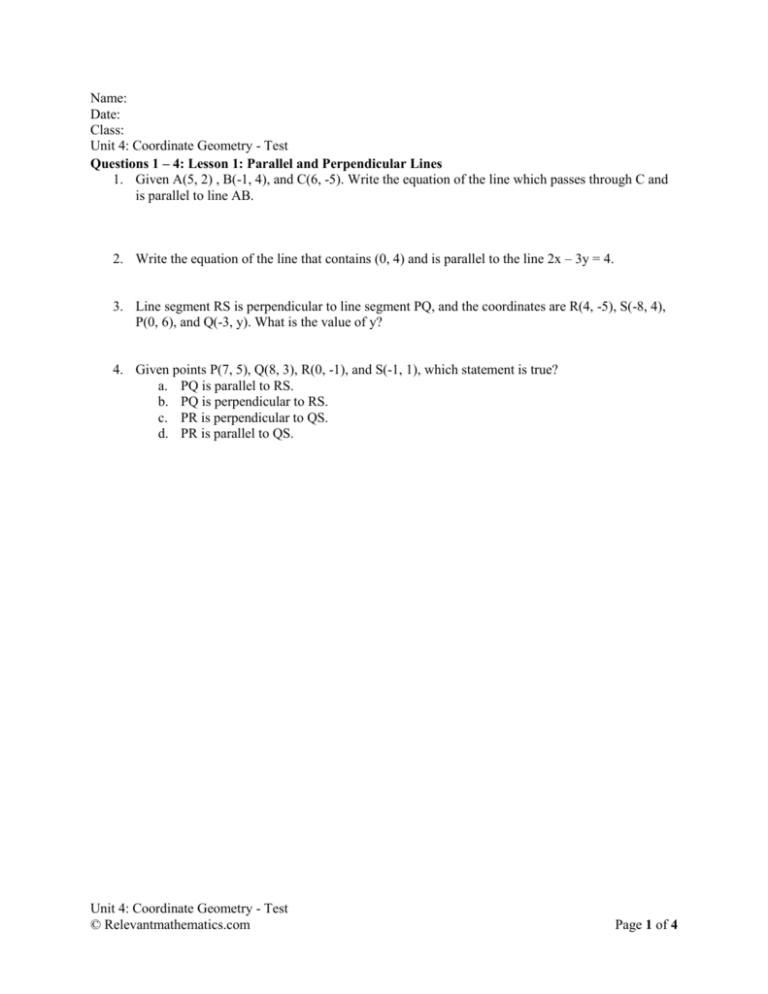
Name: Date: Class: Unit 4: Coordinate Geometry - Test Questions 1 – 4: Lesson 1: Parallel and Perpendicular Lines 1. Given A(5, 2) , B(-1, 4), and C(6, -5). Write the equation of the line which passes through C and is parallel to line AB. 2. Write the equation of the line that contains (0, 4) and is parallel to the line 2x – 3y = 4. 3. Line segment RS is perpendicular to line segment PQ, and the coordinates are R(4, -5), S(-8, 4), P(0, 6), and Q(-3, y). What is the value of y? 4. Given points P(7, 5), Q(8, 3), R(0, -1), and S(-1, 1), which statement is true? a. PQ is parallel to RS. b. PQ is perpendicular to RS. c. PR is perpendicular to QS. d. PR is parallel to QS. Unit 4: Coordinate Geometry - Test © Relevantmathematics.com Page 1 of 4 Questions 5 – 8: Lesson 2: Midpoint and Distance 5. Given the midpoint of a segment is (6, 2) and one endpoint is (1 3), find the other endpoint. 6. A triangle has vertices at (1, 3), (2, −3), and (−1, −1). What is the approximate perimeter of the triangle? a. 10 b. 14 c. 15 d. 16 7. Find the midpoint between the points (n – 5, 10) (5 – n, 4n) 8. R is the midpoint of segment PS. Q is the midpoint of segment RS. P is located at (8, 10), and S is located at (12, −6). What are the coordinates of Q? a. (4, 2) b. (2, −8) c. (11, −2) d. (10, 2) Unit 4: Coordinate Geometry - Test © Relevantmathematics.com Page 2 of 4 Questions 9 – 11: Lesson 2: Midpoint and Distance 9. The vertices of quadrilateral EFGH are E(−7, 3), F(−4, 6), G(5, −3), and H(2, −6). What kind of quadrilateral is EFGH? a. Trapezoid b. Square c. rectangle that is not a square d. rhombus that is not a square 10. Quadrilateral ABCD has vertices A(0, 0), B(2, 5), C(8, 3), and D(6, -2). Is ABCD a parallelogram? Justify your answer. Extra Credit: If Quadrilateral ABCD is a rectangle, where A(1, 2), B(6, 0), C(10,10) and D(?, ?) is unknown. 1. Find the coordinates of the fourth vertex. 2. Verify that ABCD is a rectangle providing evidence related to the sides and angles. Unit 4: Coordinate Geometry - Test © Relevantmathematics.com Page 3 of 4 Solutions: 1. y = -1/3 x - 3 2. y = 2/3 x + 4 3. A 4. A 5. (13, 1) 6. B 7. (0, 2n + 5) 8. C 9. C 10. Distance formula must be used to find the side length of opposite sides: AB = CD = 5.3 and BC = AD = √40 Slope must be calculated for opposite sides to determine if they are parallel: AB = CD = 5/2 and BC = AD = -1/3 Extra Credit: If Quadrilateral ABCD is a rectangle, where A(1, 2), B(6, 0), C(10,10) and D(?, ?) is unknown. 3. Find the coordinates of the fourth vertex. 4. Verify that ABCD is a rectangle providing evidence related to the sides and angles. 1. A student must see that they need to find a line that is parallel to AC and passes through B. y = 8/9 x + b 0 = 8/9(6) + b 16/3 = b Y = 8/9x + 16/3 Next, they need to find the equation of the line that is parallel to AB and passes through C. Y = -2/5x + b 10 = -2/5(10) + b 10 = -4 + b 14 = b y = -2/5x + 14 Lastly, students need to see that the point D would be the intersection of those two lines. Thus, they solve it as a system of linear equations. -2/5x + 14 = 8/9x + 16/3 x = 15 (15, 8) is the intersection point. 2. Through part 1, they have shown that opposite sides are parallel, but they could at this point show the slopes of the lines. Then, they need to use the distance formula to show that opposite sides are equal. D(A,B) = √29 D(C,D) = √29 D(A,C) = √145 D(B,D) = √145 Solution: http://www.geogebratube.org/material/show/id/222731 Unit 4: Coordinate Geometry - Test © Relevantmathematics.com Page 4 of 4
